Crop Protection
(Plant Pathology, Entomology and Nematology)
Introduction
The Division of Crop Protection was established in the VIII five year plan when the Directorate of Pulses Research attained the status of Indian Institute of Pulses Research on 5thSeptember 1993. The Division comprises of Plant Pathology, Agricultural Entomology and Nematology sections and engaged in basic and applied strategic research on management of major insect pests; plant pathogens (fungi, bacteria, virus, etc.) and nematodes infesting the mandate crops of the Institute. The Division is equipped with latest facilities for molecular studies on pests and pathogens.
Major Research Programmes
- Biological and molecular diversity of insect-pests and pathogens.
- Bio-ecology of major and emerging pests and diseases.
- Characterization of Biological Control agents and development of biopesticide for pest and disease management.
- Host plant resistance against major insect pests, diseases and nematodes
- Refinement of Integrated Pest and disease Management modules
- Pest monitoring and development / validation of pest forecasting models for major insect pests and diseases
- Management of stored grain pests infesting major pulses.
Infrastructure / Facilities
The Division has well equipped laboratories for research on biological control, bio-ecology, molecular biology, white fly culture facility and storage entomology. The Laboratories are equipped with latest equipments viz., Thermocycler, Gel documentation system, Fermentor, semi-automated microtome and microscopes with image acquisition and analysis system, Spectophotometer, ELISA, Deep Freezers, Refrigerated centrifuge, Refrigerated incubator shakers, Electrophoresis system, plant growth chambers, Water purification system etc.
The Division is maintaining sick plots for pigeonpea, chickpea and lentil wilts, phytophthora stem blight sick field of pigeonpea and sick tank available for Fusarium wilt race specific screening of chickpea and pigeonpea and micro-plots for Meloidogyne incognita, M. Javanica, Heterodera cajani and Pratylenchus thornei.
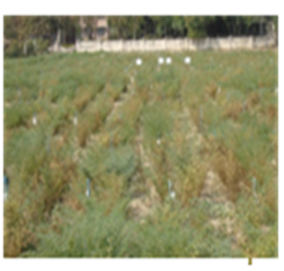
Chickpea Wilt

Pigeonpea Wilt
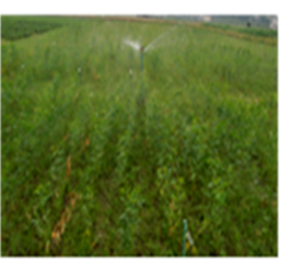
Phytophthora Blight
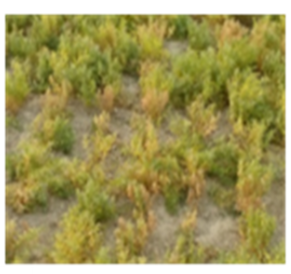
Lentil Wilt
Crop Protection Laboratory

Plant Pathology

Nematology

Entomology/ whitefly culture facility
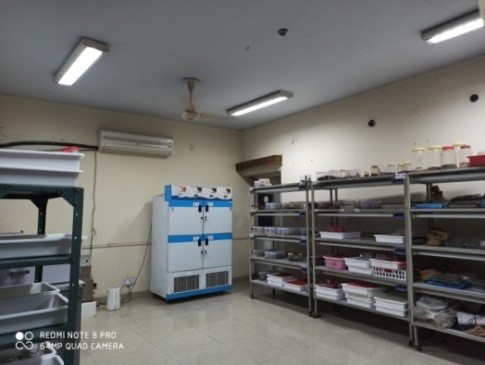
Stored grain pest lab
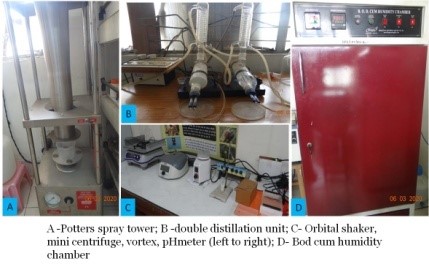
Insect bio-ecology lab
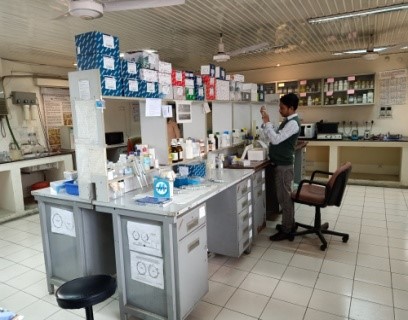
Molecular lab
Services
- Diagnostic services to the farmers for insect pests, diseases and nematodes of mandate crops.
- Advisory services on pest management to State Agriculture Department and farmers.
- Testing of newer molecules of pesticides and biorationals developed by industry/institutes.
- Guidance to M.Sc. and Ph.D. students.
- Microbial cultures of insect, pathogens and nematodes and biocontrol agents (Trichoderma, PGPRs, Bt, HaNPV, SpNPV) are available for research purposes.
Achievements
1. Host Plant Resistance
1.1 Pigeonpea
- Pigeonpea genotypes, DPPA 85-7 DPPA85-8, DDPA-85-12, DPPA 85-13 and DPPA 85-1, IPAC-67, IPAC-66 were identified as donor for Fusarium udum (Race-2) and IPAC-3, IPAPB-7-2-1-7, IPAC-79, KPBR-80-2-1 were identified as donor for Phytophthora stem blight.
- Genotypes, BDN1, BDN2, MA3, ICP 8858, ICP 8859, ICP 8863, ICP 9174, KPL 43, KPL 44 and PI 397430 were resistant to both race 2 and race 4 of Fusarium udum.
- Accessions ICP 7035, 8860, 8862, 9174, PR 5149, PI 397430 sel., DPA 85-11, 85-12, 85-13, 85-14, and lines KPL 43 and KPL 44 have been identified to possess resistance to both wilt and sterility mosaic diseases. Lines KPL 43 and KPL 44 were also found moderate resistance against Phytophthora stem blight
- Pigeonpea entries, ICP7542, PDA92-2E possessed resistance and PDA 93-IE, ICPL 129880(B), ICP 88022-1, PDA 92-3, KWR 92-02, DA 11, MA 2, NDA 99-7, MA-2 possessed moderately resistance to pod fly, M. Obtusa.
- Accessions MA-7, TT-10, H-84-5,TDRG-4, IPA-8F, BRG-11-1, BRG 10-2, RVKT 260 and accessions of wild relatives ICWP 016 (Cajanus albicans), ICWP 062 (C. platycarpus), ICWP 086 and ICWP 097 (C. scarabaeoides) were identified as resistant to Meloidogyne javanica.
- Pigeonpea lines, WD2019-45-2, WDBCE-4-5-3-9, WDBCE9-4-3-1 and WD2029-35 were identified as resistant against pigeonpea cyst nematode
- Identified two pigeonpea wild lines against analis (ICP15817, ICP15815) and 11 against C. maculatus.
- Accessions ICWP 062 and ICWP 069 of Cajanus platycarpa, a wild relative of pigeonpea were identified as resistant against Heterodera cajani.
1.2 Chickpea
- Genotypes Avrodhi, Annegeri 1, BDN 9-3, CPS 1, CPS 2, ICCV 10, ICCC 32, KPG 143-1, Phule G 5, PDG 83-84, IPCK 96-3, and JG 315 have been recommended as donors for wilt resistance. JG 74, IPC 2004-52, DCP 92-3, BCP 17, H 82-2, KWR 108, IPC 2004-3, IPC 2004-8 and IPC 2005-15 showed resistant reaction to four (1, 2, 3, 4) races of F. oxysporum f sp. ciceri
- Genotypes GL 88341, BG 360 and RSG 524 were identified as resistant sources against root knot nematodes (Meloidogyne incognita and M. javanica).
1.3 Mungbean and urdbean
- Mungbean varieties Co 4, ML 515, BM 4 and TM 98-50 and 2 urdbean lines T 65 and K 116-86 exhibited resistant reaction against CLS (Cercospora canescens).
- Mungbean genotypes PDM 139, PDM 143, ML Nos. 131, 267, 337, 408, 682, 803, 818, NDM 88-14, Pant M 4, MH 303, PBM 14, PBM 27, IPM02-03, IPM410-9, IPM205-9, IPM409-4, IPM205-7 identified as resistant to Mungbean yellow mosaic India virus.
- Urdbean genotypes NP 16, NP 19, NP 21, PLU 62, PLU 63, PLU 131, PLU 158, PLU 277, K 66-110, K 66-188, NDU 88-8, DPU 88-31, IPU13-6, IPU12-19, IPU13-5, IPU13-9 and IPU9-26 identified as resistant against Mungbean yellow mosaic India virus.
- Two mungbean varieties BPMR 1, BPMR 115 and one of urdbean viz., OBG 16 were found resistant to powdery mildew (Erysiphe polygoni).
- Identified six wild vigna genotypes resistant to two bruchid species (V.vexillata-IC248326, umbellata-IC251442, 251389, V. mungo var.mungo-IC25387, IC251385).
- Accessions of wild relatives of Vigna; V. stipulaceae (LMR/13-26), V. trilobata (IC 349701), V. trilobata (IC 331454), V. trilobata (TCR-86), V. umbellate (IC 251442) were resistant to Meloidogyne javanica.
- Urdbean genotype PLU 648, MU-44, NUL-205 were found resistant to M. javanica.
1.4 Lentil
- Lentil genotypes IG-54 and pre breeding lines (IPL406x 16-36667-1), DPL 62 have been identified as resistant against wilt. Genotypes PL 406, PL 639, DPL 15, DPL 58, DPL 62, IPL 81, Precoz and Vipasha have been found as resistant against rust.
- Genotypes L-4076, DPL-15, L-4710, L-4076, IPL-332, DPL-15, LL 1397 were identified as resistant against root-knot nematode, Meloidogyne javanica.
1.5 Fieldpea
- Fieldpea germplasm lines KPMR 28, HUDP 8, HUDP 15, KPMR 212, PM 7 and F-C-1 have resistance to both powdery mildew and rust diseases.
- Fieldpea genotypes KPMR Nos. 7, 16, 27, 212, 226, 284, 493, 516, 602, 615, 619, P3, P 4, 6238A, HUDP 8, PM 5, PM 6, JP 21, KSP 22, DMNR 34, JM 6, DMR 11, Pant P 5, HFP 4, T 10, P 185, P 388, P 6583, P 6587, P 6588, PJ 207508, C 12 and DMR 3 identified as resistant donors against powdery mildew.
- Nine field pea genotypes namely, IPFD 11-10, IPFD99-13, NDP 1200, RFP 2009-4, KPF 1028, RFP 72, HFP 8909, HFP 715, Pant P 244, KPF 101 and Pant P-243 were identified resistant against root knot nematode, M. javanica.
1.6 Rajmash
- Two accessions of rajmash EC 156011, EC 156059 have been recommended as donors for resistance against bean common mosaic virus. Genotypes EC 8447, ET 4118, BPG 116306, Vermelho 2152 have also been found to be resistant against bean common mosaic virus.
- Viruses found associated with leaf curl disease included: Tomato leaf curl Gujarat virus (KF440686), French bean leaf curl virus (FbLCV-Q866297) and French bean severe leaf curl virus (FbSLCV-NC_018453). These viruses were reported for the first time from rajmash. FbLCV and FbSLCV are new species. The former has a monopartite genome typical of Begomo virus and latter has a unique genome organisation and has been assigned to a newly created genus Capula virus of Geminiviridae.
2. Bio-ecology
- Field infestation window by two bruchid species, Callosobruchus maculates , and C. analis L., on cowpea and mungbean was initiated during 3rd and 4th weeks after flowering (WAF), respectively and infestation was gradually increased towards crop maturity when majority of the pods were dried. The field infestation was further confirmed in stored grains representing respective field infestation window.
- Stem rot disease caused by Sclerotinia scleriotiorm (lib.) de Bary. of pigeonpea was reported for the first time from India (Fig 1).

Fig 1. Stem rot disease in pigeonpea
- Groundnut bud necrosis virus (GBNV) infection was reported for the first time in pea, rajmash and several species and sub-species of wild Vigna species/sub-species.
- MYMIV infection was reported for the first time in various accessions of wild Vigna species/sub-species.
- Simplex-PCR detection protocols of 10 viruses (MYMIV, MYMV, HgYMV, DoYMV, FbLCV, FbSLCV, ToLCGV, ToLCNDV-Lentil, CCDV and GBNV) were developed and validated.
- Three kits namely “LYMVs PCR Diagnostic Kit”, “LYMVs Direct PCR Kit” and“LYMVsMplex” were developed for the detection of four viruses (MYMV, MYMIV, HgYMV and DoYMV) causing yellow mosaic in pulse crops (Fig 2).

Fig 2. PCR plant virus diagnostic kit
- French bean severe leaf curl virus (FbSLCV), a new geminivirus was found to be associated with rajmsh, lentil, urdbean and pigeonpea for the first time.
- The association of Tomato leaf curl Gujarat virus (ToLCGV) and French bean leaf curl virus (FbLCV) with leaf curl symptoms of rajmash was confirmed for the first time.
- Pigeonpea pods of about 15-20 days old were preferred for oviposition by pod fly, M. obtusa which is considered to be a critical stage for insecticide application.
- Podfly incidence increased abruptly when, maximum temperature exceeded> 27°C and minimum temperature rose above 12°C.
- Economic threshold levels (ETL) of gram pod borer (Helicoverpa armigera) in chickpea and pigeonpea have been worked out. One larva can damage 20-25 pods in lifetime. It attains to ETL when 5-6 male moth /trap per night are recorded during post-winter months.
- Grain yield of urdbean cv Uttara was reduced 50.9% in Heterodera cajani infested plots compared to un-inoculated plots also Heterodera cajani infection reduced the total protein content of the grains
- Viability of eggs of Heterodera cajani in cysts was recorded for more than 3 years but less than four years without host in moist and dry soil.
- Twelve nematode genera were reported from chickpea rhizosphere in Bundelkhand region. The most frequently encountered genera were, Tylenchorhynchus spp. followed by Pratylenchus spp. and Tylenchus spp. Eleven nematode genera were reported from pigeonpea fields in Hamirpur district of Bundelkhand, wherein most frequently encountered nematodes were Tylenchorhynchus sp. and Tylenchus sp. followed by Heterodera cajani.
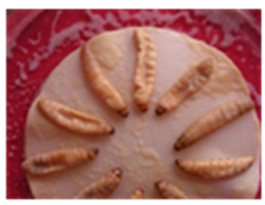
ENP infected Galleria Larvae
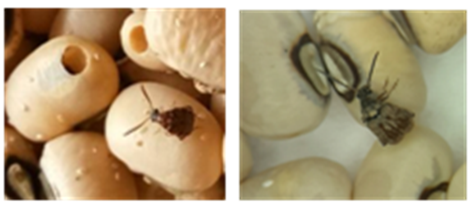
Pulse Beetle infestation in cowpea

Pod borer in chickpea and pigeonpea
3. Biological Control of Phytopathogens
- A total of >200 isolates of Trichoderma belonging to 9 different spp. ( harzianum, T. asperellum, T. afroharzianum, T. virens, T. longibrachiatum, T. atrobreuneum, T. bravicompactum, T. asperelloides, T. aureoviroides) were identified and characterized from different pulses (chickpea, pigeonpea, lentil, fieldpea, green gram and black gram) rhizosphere across the country.
- All the Trichoderma isolates were meticulously tested for management of wilt, dry root rot, collar rot, stem rot pathogens of chickpea, pigeonpea, lentil and fieldpea and plant growth promotion potential.
- Identified the most potential 20 Trichoderma isolates for disease suppression ability and growth promotion potential. There are deposits to ICAR-NBAIM, Mau, as the national depository.
- Two multi-trait Trichoderma strain (IIPRTh-31, asperellum) and (IIPRTh-33, T. afroharzianum) have been registered with ICAR-NBAIM Mau (NAIMCC-R- 5 and NAIMCC-R- 6).
- Developed a talc based formulation of registered Trichoderma strain i.e. DALHANDERMA and DALHANDERMA-1 for further commercialization through ICAR- Agri innovate.
- Mycolytic gene (ech- 42 and xyn-2) and secondary metabolites (1,2 Benzene dicarboxylic acid and 2H pyron-2n) were characterized from potential Trichoderma isolates.
- Identified potential rhizosphere bacterial strain (Bacillus subtilis, amylolignifaciens, B. haynerii, B. altitudinus and Pseudomonas guariconensis) for biocontrol and plant growth promotion ability in pulses.
- Developed a DALHAN Bio-Consortia ( asperellum + B. subtilis) as biostimulants.
- Identified and characterized high salt tolerant Trichoderma strain ( harzianum, IIPRTh-4) and heavy metal (Cd, Cr, Pb, Zn) tolerant microbial strain for ecologically safe plant protection and further utilization in bioremediation.

4. Biological Control of Insects
- Two native Bt isolates viz., F8.IIPR & AK2.IIPR were identified and characterized its insecticidal potency for eco-friendly management of Bihar hairy caterpillar, Spilosoma obliqua Walker, helicoverpa armigera hubner and Spodoptera litura fabricius
- SpobmNPV (Spilosoma obliqua Nuclear Polyhedrosis Virus) was identified and characterized against S. obliqua. SpobmNPVpolh gene sequence was submitted to NCBI (KT877650).
- DNA barcode based on CoI gene of Spilosoma obliqua, Maruca vitrata, Olepa ricini and Olepa sp. was developed and submitted to NCBI (KX810194; KY559101; KY559102 and KY559103).
- Insect pathogenic virus, HearNPV-IIPR05 isolate was identified against Helicoverpa armigera. The phylogeny based on amino acid sequence of three core genes (Polh, Lef-8, Pif-1) revealed that the isolate belonged to the genus Alphabaculo virus and Group II NPVs.
- Five entomopathogenic nematode isolates were characterized and identified as Stenernima siamkayai and found potential biocontrol agent against pupal stage of Helicoverpa armigera.
- 200 native isolates of Trichoderma species ( harzianum, T. viride, T virens), one isolates of Pseudomonas, one of Bacillus sp. and four species of mycorrhizal fungi (Glomus intraradices, G. mussae, G. fasiculatum, G. itinucatum) has been isolated from pulses rhizosphere.
5. Biological Control of Nematodes
- Seven isolates of obligate bacterial parasite, Pasteuria penetrans (IIPR-Pp-1 to IIPR-Pp-7) were isolated, identified and evaluated for management of root knot nematode, Meloidogyne incognita in chickpea.
- Fourty eight (48) well characterized strains (10 strains of nematode egg parasitic fungi, Purpureocillium lilacinum; 12 strains each of Trichoderma harzianum, asperellum; 14 strains of rhizobacteria, Bacillus cereus) were submitted and received accession number from NAIMCC, NBAIM, Mau.
- Consortium of potential strains of various nematode bio control agents viz., Purpureocillium lilacinum (NAIMCC-F-04234), Trichoderma harzianum (NAIMCC-F-04262), asperellum (NAIMCC-F-04274), Bacillus cereus (NAIMCC-TB-3853) and Streptomyces ginkgonis (NAIMCC-F-02732) were developed and evaluated for management of Meloidogyne incognita in chickpea
- Whole genome sequencing and de novo assembly, structural and functional annotation of nematode egg parasitic fungi, lilacinum IIPR-Pl-11 Strain has been carried out.
6. Pest Management
- Among 11 bio-rationals / chemical insecticides evaluated against M. vitrata, the lowest pod damage (4.8%) with high cost benefit ratio was recorded in Indoxacarb 14.5 SC treated plots followed by Spinosad 45SC (5.2%) as against 15.4% in untreated control.
- Yield losses due to powdery mildew and rust in fieldpea can be easily avoided if sowing is done during the first week of November. For late sown crop, one or two foliar sprays at ten-day intervals, of wettable sulphur @ 0.3 % starting at the onset of the disease can take care of both powdery mildew and rust.
- One to two foliar sprays of carbendazim 50 WP @ 0.025% or thiophanate methyl 70% WP @ 0.05% have been found very effective in controlling Cercospora leaf spot disease in mungbean.
- Seed treatment with 3% carbosulfan has been found most effective in management of root knot nematode in chickpea. Carbosulfan in combination with carbendazim (0.1%) is also effective. Among neem-based formulations, Nimbecidine (0.2%) is superior in nematode management.
- Field sanitation+ seed treatment + intercropping/mixed cropping of sorghum and use of moderately resistant cultivars has reduced wilt incidence in pigeonpea
- Intercropping of mustard with chickpea has been found effective in management of gram pod borer and root knot nematode.
- Urdbean + Sorghum (3:1) followed by Wheat, Urdbean followed by Wheat + Mustard (8:1) reduced population of parasitic (RK) nematode significantly (76-83%).
- Non host crops of pigeonpea cyst nematode such as linseed, pearl millet, maize or wheat are required to grow for at least 2 years to reduce the cyst population in Heterodera cajani infested fields.
- Application of neem seed powder in soil @ 12.5 kg/ha + farmyard manure @ 5 t/ha in combination with seed treatment with carbosulfan 3% (w/w) controlled root-knot nematode and increased yield in urdbean.
- Application of neem cake @500kg/ha at the time of sowing helps in reducing the root knot nematode infestation in chickpea.
- For prophylactic control of bruchid, treating pulse seeds with mustard oil or non-edible oil like neem, mahua or karanj oil @ 10 ml / kg seed or activated charcoal @ 10 g / kg seed is recommended.
7.Variability in wilt pathogens of pigeonpea and chickpea
- More than 500 Fusarium udum isolates were collected across the country and characterized on seven wilt differentials. On the basis of their pathogenic reactions isolates were grouped into five udum races present in the country.
- Identified six Foc races in the country based on the differential reactions of 326 representative isolates of Fusarium oxysporum sp. ciceri collected across the country
Scientists and their area of specialization


















